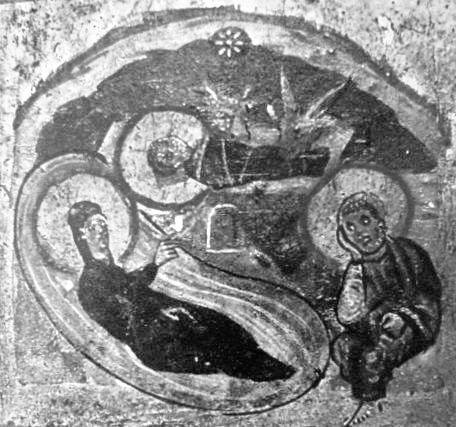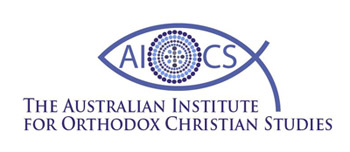by Anna Silvas, FAHA
What profound things one begins to see here.
First of all to note: Behold from this time forth I make you hear new things, things hidden which you have not known (Isa 48:6), adumbrates Behold, I make all things new (Apoc 21:5). As I went through this chapter, I took the point of the NJB note: “The severe tone of the prophecy is surprising in the prophet of Consolation [Deutero-Isaiah].”
It came to me that this stiff-necked, recalcitrant, O so unworthy Israel, is simply humanity in general. Because I knew that you are obstinate, and your neck is an iron sinew, and your forehead brass, …(Isa 48:4). Israel was called out by the Lord as a concentrated proxy, a trial run, a “beta version” of the whole of fallen mankind summoned to salvation. The sins of Israel are the sins of the nations, the sins of all of us.
Again, the solemn, steady tolling of the divine I am. You know that our father St John, spiritual son of Mary, is pondering these very texts, and pointing them to God the Word incarnate in his Gospel.
Listen to Me, O Jacob, and Israel, whom I have called (lit. ‘my called one’): I am He; I am the first, and I am the last. (Isa 48:12) That is: שְׁמַ֤ע אֵלַי֙ יַֽעֲקֹ֔ב וְיִשְׂרָאֵ֖ל מְקֹרָאִ֑י אֲנִי־ הוּא֙ אֲנִ֣י רִאשׁ֔וֹן אַ֖ף אֲנִ֥י אַחֲרֽוֹן׃ / Ἄκουέ μου, Ἰακώβ, καὶ Ἰσραὴλ ὃν ἐγὼ καλῶ· ἐγώ εἰμι πρῶτος, καὶ ἐγώ εἰμι εἰς τὸν αἰῶνα.
Thus says the LORD your Redeemer, the Holy One of Israel: “I am the LORD your God… (Isa 48:17a). That is: כֹּֽה־ אָמַ֧ר יְהוָ֛ה גֹּאַלְךָ֖ קְד֣וֹשׁ יִשְׂרָאֵ֑ל אֲנִ֨י יְהוָ֤ה אֱלֹהֶ֙יךָ֙ / οὕτως λέγει Κύριος ὁ ῥυσάμενος ἅγιος Ἰσραήλ Ἐγώ εἰμι ὁ θεός σου,…
This may be an inspiration from on high: The true answer to the proud and autonomous I am (Isa 47:10) of the previous chapter, the radical cure of the ruinous usurpation of the divine I am, is a different sort of first-person singular predication: הִנֵּֽנִי, hinneni (behold here I am, Latin: adsum), and all its related forms. The thing about this self-identification hinneni is that it is absolutely and prototypically relational. It expresses my being, or the being of the one professing it, as intrinsically before another, in response to another.
From a sort of Jewish Christian website, I copy this explanation of hinneni, because I think it is so good:
What makes ‘hineni’ such a powerful statement? It is an offer of complete availability, of total readiness to serve. When we utter ‘hineni’, we make ourselves fully available to whatever it is God might ask of us. Even without knowing what that might be. The answer of ‘hineni’ is one of faith.
I am only going to post a note on a point worth further exploration, but there is, even on God’s side, the deepest connection between the proclamation of the divine name, the divine I am, to us, and this first-person singular form, הִנֵּֽנִי. It is revealed sublimely in Isa 65:1—and compare the pattern of the divine voice calling in Gen 3:9, Apoc 3:20, Song 5:2, Jn 10:3, and many other passages.
I was ready to be sought by those who did not ask for me; I was ready to be found by those who did not seek me. To a nation that did not call on my name, I said, “Here I am, here I am”.
נִדְרַ֙שְׁתִּי֙ לְל֣וֹא שָׁאָ֔לוּ נִמְצֵ֖אתִי לְלֹ֣א בִקְשֻׁ֑נִי אָמַ֙רְתִּי֙ הִנֵּ֣נִי הִנֵּ֔נִי אֶל־ גּ֖וֹי לֹֽא־ קֹרָ֥א בִשְׁמִֽי׃
Ἐμφανὴς ἐγενήθην τοῖς ἐμὲ μὴ ἐπερωτῶσιν, εὑρέθην τοῖς ἐμὲ μὴ ζητοῦσιν· εἶπα Ἰδού εἰμι, τῷ ἔθνει οἳ οὐκ ἐκάλεσάν μου τὸ ὄνομα. (Is 65:1)
This explicit divine hinneni revealed in Isaiah, hints that the divine I am, from the Lord’s side, is also intrinsically and primordially relational. It discloses in the proclamation of the divine name this sense: Behold I am, I am here, I am here for you. It is surely teaching us that the fons et origo of all relations of persons, of God and man, and man and man in God, is the divine initiative. This dialectic and drama, ordered to the communio personarum (communion of persons) begins from God and in God.
 We are in deep Advent right now, and we just had this morning one of the loftiest utterances concerning Mary in the Church’s tradition: St Bernard’s ardent, loving, imaginative appeal to Mary on the threshold of her response to the angel. It dawns on me that Mary’s response, the culmination of Bernard’s address, is a perfect hinneni: Behold, I am the handmaid of the Lord: be it done unto me according to your word (Lk 1:38). And here is the thing. It is then matched by our Lord’s own perfect hinneni to the Father as he takes flesh in Mary’s womb: Then I said, ‘Here I am, as it is written of Me in the scroll: I am coming to do Your will, O God’” (Heb 10:7).
We are in deep Advent right now, and we just had this morning one of the loftiest utterances concerning Mary in the Church’s tradition: St Bernard’s ardent, loving, imaginative appeal to Mary on the threshold of her response to the angel. It dawns on me that Mary’s response, the culmination of Bernard’s address, is a perfect hinneni: Behold, I am the handmaid of the Lord: be it done unto me according to your word (Lk 1:38). And here is the thing. It is then matched by our Lord’s own perfect hinneni to the Father as he takes flesh in Mary’s womb: Then I said, ‘Here I am, as it is written of Me in the scroll: I am coming to do Your will, O God’” (Heb 10:7).
You begin to see the most solemn, sublime dance of persons, persons divine and human here, the most incredible perichoresis. It all begins with the overture of God’s hinneni to Mary, in the form of Gabriel’s salutation (the Lord is with you); it is answered after dialogue by Mary’s hinneni to Gabriel, and through him to God, which is answered in turn by the hinneni of the Son to the Father even as he takes flesh in Mary’s womb. Wow, but this is listening and hearkening, this is real obedience, this is love. There is certainly the nuptial mystery at work here, this is all the most sublime communio personarum. And it all took place so quietly, so hiddenly, an ontological shock wave that re-verb-erated, and reverberates ever, through the whole universe.
I conclude my musings with a little note of thanks to Leonard Cohen who so heightened my sense of this most pregnant Hebrew word, הִנֵּֽנִי, this form of a first person singular predication that so beckons us, that so calls us. Apparently there is a Hinneni chant used at Rosh Hashana and Yom Kippur in Orthodox Jewish synagogues, and a cantor from Cohen’s ‘home’ synagogue in Montreal features at the end of his song, You want it darker, in his last album of that name. Have great mercy on his poor soul dear Lord, and please, upon mine too.
Dr Anna Silvas is Fellow of the Australian Academy of the Humanities. She also is Adjunct Senior Research Fellow in Faculty of Humanities, Arts, Social Sciences and Education; School of Humanities, Arts, and Social Sciences, the University of New England, Armidale NSW.
Image credits
Aboriginal art symbol for people sitting together
23 December 2021 © AIOCS
AIOCS LTD is a not-for-profit charitable organisation that promotes the study of Orthodox Christianity, Eastern and Oriental, in Australia
For donations, please go to https://www.paypal.com/paypalme/aiocsnet or contact us at info@aiocs.net

